By Jeffrey A. Rendall; Images Courtesy of TaylorMade Golf
CARLSBAD, CA – Hit it longer, have more fun.
People always want more – higher positions, bigger houses, more toys, and more satisfaction. It’s an insatiable individual drive towards status and perfection that transcends existence. Darwin called it Natural Selection. We’ll call it human nature.
On the golf course, we want more, too, but usually it’s in terms of distance. And if you’re craving that extra few yards, it’s always a safe bet to look towards TaylorMade to provide it. While the Carlsbad-based company has always been a technological leader in providing those incremental extra measurements, its latest products go the proverbial one step further – speaking of the r7 XD Irons and r7 425 and r7 460 Drivers.
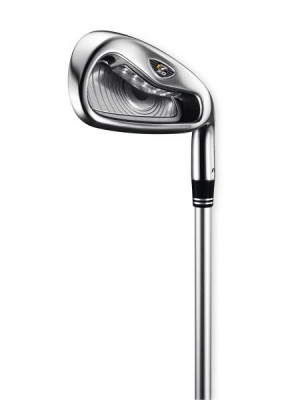 |
Gary Gallagher, TaylorMade’s Global Products Marketing Manager explains the thinking behind the r7 XD Irons: “Simply put, the XD stands for extra distance. Every performance element, from the shaft to the CG (center-of-gravity) position is aligned to hit the ball far. If swing speed is equal in a test situation, these irons will hit it farther than most any iron on the market.”
For those having played golf for any appreciable time, you know distance isn’t everything, especially with a set of irons. But it never hurts to have it either. We see the pros on TV hitting short irons from amazing distances and wonder why we can’t do it the same way. There are a number of factors why, but it certainly has something to do with the way the clubs are made, and hence we get a legally ‘suped up’ iron set like the XD’s.
And even more enticing, they’re not made for the pros – they’re made for the masses. “The XD was designed for the average player, not the skilled player,” Gallagher explained. “Highly skilled players are generally less interested in an iron that generates distance but rather in an iron that they can be accurate with.”
That may be true, but some pros like the XD version, including Englishman Kenneth Ferrie, the rather colorful gentleman who was near the lead for most of the 2006 US Open. He carries the XD’s, which gives you some idea of their versatility. Because of their large size, they’re very forgiving, which even better players will enjoy in the harder to hit longer irons.
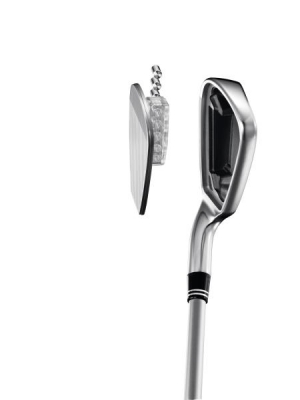 |
There’s the inevitable question of ‘why’ these clubs will hit it longer than other irons, and why they’re longer than their predecessors. For the answer, look to TaylorMade’s ‘money’ franchise, its metal woods: “The XD uses a technology that we employ with our drivers. The face is manufactured separate from the head, which we call ‘Pull-Face’ Construction. The body is steel and the titanium face is milled thin. The face is fast, making for a higher coefficient of restitution (COR),” Gallagher said.
The infamous COR, usually employed when talking about the legality of driver faces – those that push the limit, and those that have passed it. Now we can talk about the COR with irons, too.
Gallagher elaborates on the XD’s technical side: “The titanium face allows us to save weight and position it lower and back (which puts the center-of-gravity down low in back), making it easy to launch the ball high – so high, in fact, that we had to de-loft the face to keep the ball under control. This combination creates a high launch-angle and lower spin-rate which adds up to more distance.”
There’re additional similarities to the driver technology. The r7 XD features ‘Inverted Cone Technology,’ the same concept found in TaylorMade’s drivers for the last three years. This increases the size of the COR zone (the area where you’ll get maximum distance), which helps maintain distance for off-center hits. Translation – you’ll get better average distance from shot-to-shot.
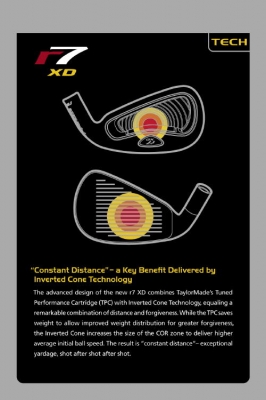 |
One thing the r7 XD’s did not borrow from the r7 drivers was movable weights. Gallagher explains why: “Moving weight to create different launch conditions in order to enhance distance and accuracy has been very successful in TaylorMade’s metal woods. But the challenge in applying Movable Weight Technology (MWT) to irons is finding enough weight to move, and moving it far enough to change the ball flight. If we can do this effectively in the future, we’ll have an iron with MWT.”
That will be interesting to see. In the meantime, Gallagher has some advice for people looking for new irons, the r7 XD’s, or otherwise: “First, you should pick a style of iron head that suits your game – for example, large and forgiving, or small and workable. Next, choose a shaft that meshes well with your swing characteristics in terms of flex, tip stiffness, etc… Then select two to four irons that fit your profile and test them to see which feels the best and reacts best with your swing. Many companies offer information about their irons that a consumer can investigate before going into the shop (including TaylorMade, on their website), so that’s a good place to start.”
While you’re in the shop, it’ll be convenient to check out the latest in TaylorMade’s drivers as well, the r7 425 and r7 460. The company introduced the revolutionary new r7 franchise three years ago, complete with its movable weights, and the buzz has never stopped since.
As alluded to above, Movable Weight Technology (MWT) is the key component for these drivers. These newer vintage r7 drivers are larger than the original (which was 400cc), with 425cc and 460cc heads respectively, but the differences don’t stop there. The 425’s four MWT ports are spread farther apart, and it comes with more movable weight. The r7 460 is larger still, with two MWT ports.
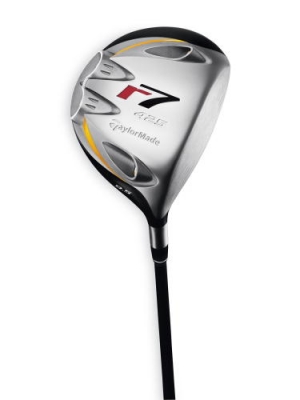 |
In terms of performance, it would be hard to improve on the original r7, but the newer clubs do it. “The r7 425’s larger head, wider-spread weight ports and the increased amount of movable weight allows you to move the center-of-gravity farther, which promotes greater changes in ball flight. Also, the larger club head is more forgiving. The r7 460 is the best performer in the 460cc category because it incorporates MWT, allowing you to promote changes in ball flight for greater distance and accuracy,” Gallagher added.
Some companies (including TaylorMade) have incorporated the weight shift into their heads automatically, introducing ‘biased’ clubs that will produce certain ball flights. The r7 425 and r7 460 allow you to change things up a little. With the different bias ‘options’ you achieve in the same club, it’s like having a bag full of drivers.
Materially speaking, the 425 and 460 models are the same as the original r7. “It’s the same 6-4 Titanium,” Gallagher instructed. “The performance benefit comes from the Ultra-Thin Wall casting that we use in the r7 425 and r7 460. Ultra-Thin Wall casting allows us to cast the crown of the driver at .6mm thin. The ability to cast a wall this thin gives us the discretionary weight that we need to incorporate MWT into a 425cc and 460cc club head.”
The design has certainly brought about success. The original r7 Quad driver was the number one driver on the PGA Tour in 2003 and 2004. The r7 425 took over the top spot in 2005 and still maintains it. It shows that the pros are buying into the Movable Weight Technology – and that they can adjust the club if course conditions change or when they go to a new course. Flexibility is good in the game of golf.
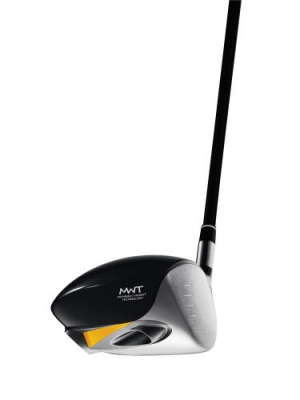 |
Of course, TaylorMade feels they’re more flexible, and superior to the competition. Gallagher tells how: “We think our performance technologies, like MWT, Inverted Cone Technologies and RE*AX shaft technology, which were developed to help all types of golfers hit longer and straighter shots, makes our equipment perform better than any other company’s. Besides our dominance on the world’s pro tours, our metal woods rank number one in the US in terms of dollar market share. We encourage golfers to test our clubs against the competition to discover the differences for themselves.”
We did just that, with the r7 XD Irons and the r7 425 and r7 460 drivers. We’ve been trying TaylorMade products for years, and can honestly say there’s never been a driver or set of irons that we haven’t liked. The XD irons’ head size is a bit larger than we’re used to and took a period of adjustment, but after some time, were just as familiar as any other irons. And the claims of distance and forgiveness are certainly accurate – almost to the point of needing a period of adjustment in and of themselves.
More distance is a good problem to have, but you’d better try them on the range before you take them to the course, or you may find yourself over-shooting some of the targets. You won’t be short changed on ball flight either, as it’s easy to get these irons off the ground and you’ll admire the amount of air you command.
The 425 and 460 drivers are pure TaylorMade dependable – extremely easy to hit and providing excellent distance. The weights are easy to move, and the chart provided is very helpful in getting the weight pegs to the right places. For someone whose ball flight is as fickle as the day of the week, it was interesting to see the different ‘corrections’ you can achieve just with the turning of the wrench.
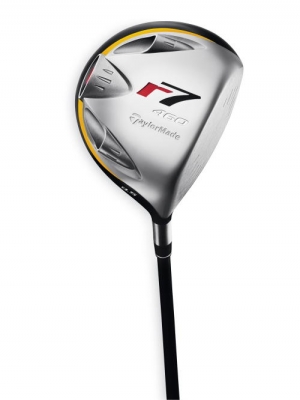 |
Playing partners trying out the clubs had similar observations, and there was no shortage of folks willing to try them. As with the irons, Gallagher recommends that you find your individual driver specifications, then try a whole host of models to see which ones you like best. TaylorMade is confident enough to risk the comparison (and in all fairness, so are the other manufacturers) and believe you’ll like their products.
Seeing as TaylorMade has introduced a number of new products in recent times, I asked Gallagher if there’s more room, within the rules, to keep making ‘better’ golf clubs. The answer is yes.
“The box that engineers have to design within has gotten smaller, but we feel that there’s certainly room remaining in it to design equipment that delivers more distance and forgiveness while staying within the guidelines that the USGA sets,” Gallagher said.
So feel comfortable in demanding more, because you’re going to get it, at least on the golf course.
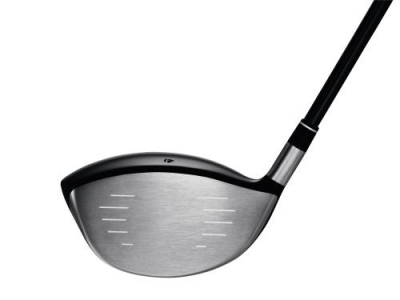 |
Note: TaylorMade also produces a TP version of the r7 425 & r7 460 (for professionals and low handicappers). Here are the key differences:
- Higher quality shaft choices that lower handicappers tend to prefer.
- Square to slightly open clubface favored by low handicappers (the 460 is a couple degrees shut, like most other production drivers).
- The TP comes with four weights for more trajectory choices (the 460 comes with two).
Details:
TaylorMade r7 XD Irons, r7 425 & r7 460 Drivers
Available at your higher-end golf retailers and club pro shops.
Check out more information about TaylorMade products at: http://www.taylormadegolf.com/.
| Related Links | Comments on this article? | |
|
Maryland National Golf Club Hollow Creek Golf Club Rocky Gap Resort PB Dye Golf Club in Ijamsville Whiskey Creek Golf Club |
E-mail Jeff Rendall, Editor: jrendall@golftheunitedstates.com |












